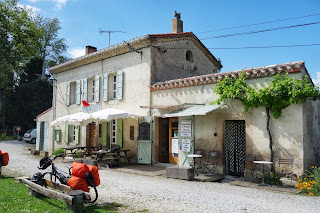We chose to stay at the camping ground at
Avignonet-Lauragais as the surface from there to Toulouse is great and the run
into the city, of about 50km seemed a good distance. The weather was on our side. Smooth run, blue skies, cycle-touring as you would
like it.
Bonus 1: Sometime before lunchtime there is
access to a picnic area for motorway traffic, with tables to sit at for a snack
right by the canal and real toilets – with paper!
 Bonus 2, at about lunchtime and at about
half-way, we were passing through a village actually on the canal (not
very usual) and had a plate of local cold cuts and bread at the local bar. No
doubt we had a beer too, but it is the food part I recall best. Great stuff! The goose wasn't actually at the same place - but not far away!
Bonus 2, at about lunchtime and at about
half-way, we were passing through a village actually on the canal (not
very usual) and had a plate of local cold cuts and bread at the local bar. No
doubt we had a beer too, but it is the food part I recall best. Great stuff! The goose wasn't actually at the same place - but not far away!
The run was so smooth we got to Toulouse
station (right on the cycle track, as stations often are) mid-afternoon. No
rush to get a train out to Colomiers, where Chris used to live for a while when
he first arrived in Toulouse in 2006 and where I also stayed in 2007. (Thanks
guys – you know who you are!) From there we could bike to Cornebarrieu, about
5km as the crow flies and more with roundabouts to negotiate. Turn at McDonalds, carry on, left at the T
junction, consult Google maps, carry on, ask the guy outside the baker’s where
the street is…this IS the street. (No street name anywhere there). You’re
looking for the English people? (never mind that they’ve lived here practically
for ever) – just up the street. We ring
the doorbell – our hosts are expecting us about now…
But that is for another day. The Canal du
Midi ends at Toulouse – and so ends the first leg for us.
12th June 2013. (392km)






























